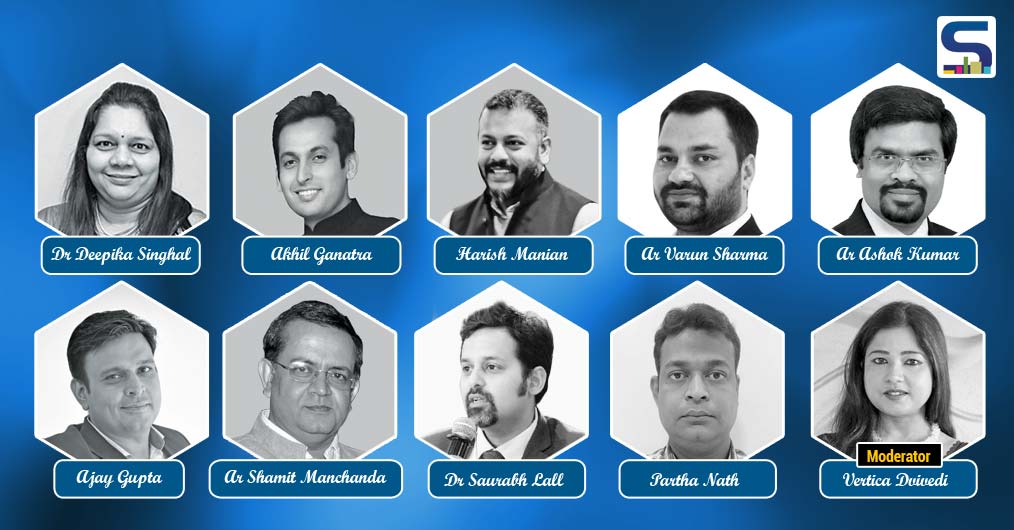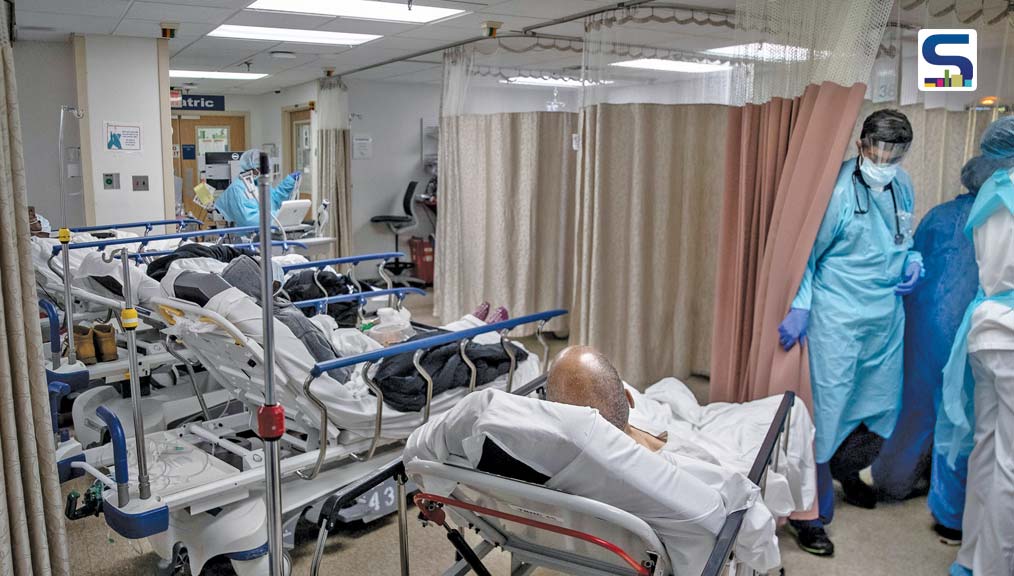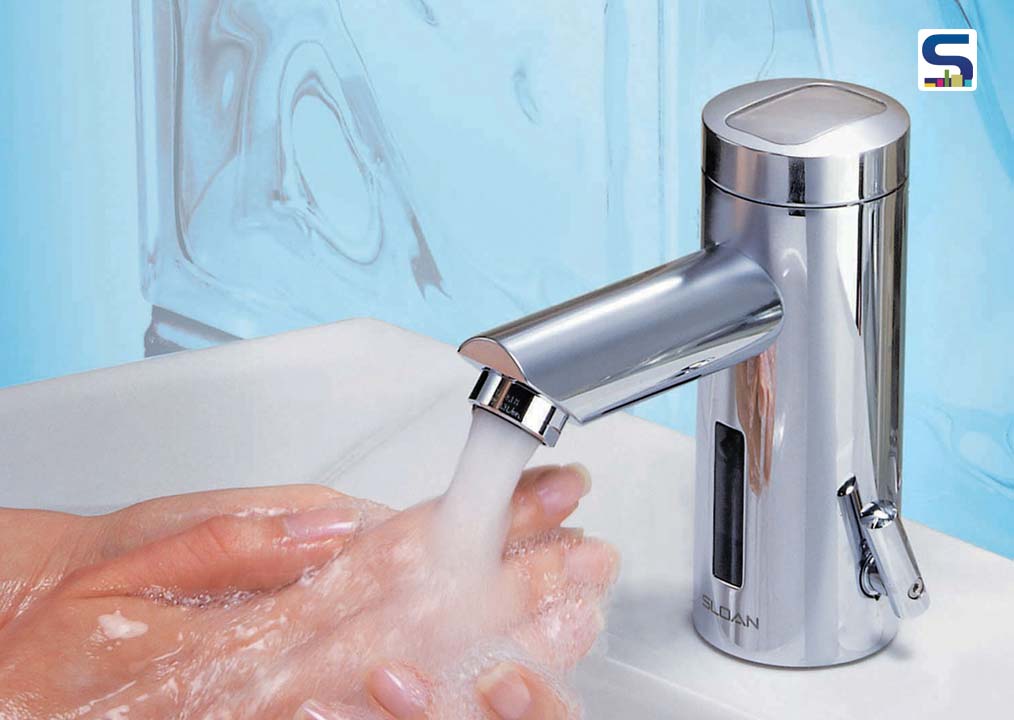
This article is in continuation to our previous article - How COVID 19 is Causing A Major Shift in Healthcare and Hospital Design?. In the last section, SURFACES REPORTER (SR) covered how the COVID-19 pandemic has impacted worldwide healthcare infrastructure design. Here, in this part, we will elaborate on the changes we will see in the healthcare infrastructure design, in terms of material and products. Read on:
Also Read: In Conversation with Mukesh Savlani, President and CEO, Welspun Flooring
This pandemic has made architects, designers and material developers to look beyond the immediate crisis and brainstorm the fast and efficient design solutions to inhibit disease transmission in buildings and, in the long term, how to design buildings better for future epidemics. Ar Shamit Manchanda, Partner, Manchanda Associates, Dr Deepika Singhal, Board Member, Action Group of Hospitals, Harish Manian, CEO, MGM Healthcare, Dr Saurabh Lall, Head of Hospital Operations, MAX Healthcare, Ar Ashok Kumar, President - Principal Architect, ARCH-EN-DESIGN, Lucknow, Ajay Gupta, Executive Director, KGD-Architecture, Bangalore, Akhil Ganatra, MD & Healthcare lead of Clancy Global, and Mr Partha Nath, DY, General Manager, GreenPly joined in the SURFACES REPORTER (SR) webinar on Top Strategies for a New Healthcare System Post Covid-19- Architecture & Design, and shared their views. Our complete report is based on the assessments made by the expert architects, designers, analysts and industry leaders. Take a look:

More Flexibility in design
Designers are anticipating that future hospitals should have more flexibility into their operational systems for such outbreaks. Flexibility in the design should be like that it quickly transforms the regular beds into an ICU ward.
There should be momentarily having the capacity to expand in the time of crises or emergencies and contract when they are over. And the car parking spaces should also be designed in such a way that they can be converted to a temporary containment zone.
Large Triage Areas
There will be a need for large triage areas so that the patient won’t need to wait for a long time at hospitals. The recent announcement by the government is also highlighting the need for setting up infectious disease wards and proper labs at every district level. So, there is a need to design hospitals to run both as COVID hospitals as well as non-COVID hospitals. “In terms of detailing, at the moment, we have to triage only an emergency ward. Now we will have to have large triage areas for segregation of patients right at the entry of the hospital. Triaging is going to be very important,” says Ar Shamit Manchanda, Partner, Manchanda Associates.
 Image Credit: The New York Times
Image Credit: The New York Times
Many hospitals are looking for ways to increase the seating spaces, so there is a safe distance between each of the individuals. To properly adapt the social distancing concept, there is a new design requirement where there is more space between the beds. Future Waiting Lobbies In Smaller Clusters: the entrance and waiting areas for patients’ family members or relatives may be limited to a certain maximum. And there is a specific minimum spacing between the seats. So, there will be more physical distance between people and healthcare staff within the facility.
Harish Manian CEO, MGM Healthcare said, "Technological innovations such as thermal imaging in healthcare, UV disinfection in healthcare and telemedicine will be adopted by people.”
Hygiene Protocols
Although COVID-19 has disrupted daily lives in many ways, Harish Manian sees a silver lining to it. He states, “the compliance of hand hygiene has become 100 per cent because of COVID and this was a battle across all the hospitals to get 100% hand hygiene compliance. So, what has happened because of that is the cross-infection rate across hospitals has become completely zero.”
Proper hand hygiene, sanitizing equipment and PPE protocols will be a priority in hospitals and clinics. We would see signage for proper hand hygiene in all seating areas or restrooms. The use of hand sanitizer will be required for all patients, attendees, visitors or others in the hospitals. All diagnostic tools especially that require close contact are installed with ‘sneeze guards’.
Tangible and Intangible Aspects
Ar Ashok Kumar, President - Principal Architect, ARCH-EN- DESIGN, Lucknow, emphasizes the tangible and intangible aspects of the healthcare infrastructure. He says all the components of tangibles such as PPE kits, the mask and sanitizers and intangibles like infrastructure facilities will come a long way in terms of giving a big relief.
OPD Consultation Rooms with Video-conferencing Solutions
As the government has already issued a guideline on telemedicine, many hospitals had already switched to online consultation during the lockdown and it is projected to become the part of OPD design post-COVID as well.
“Technological innovations such as thermal imaging in healthcare, UV disinfection in healthcare and telemedicine will be adopted by people,” said Harish Manian, CEO, MGM Healthcare.
Zero-Carbon Emission in Design
The most important way through which architects and designers can fight the climate crises is by adopting carbon-neutral design to offer better spaces and experiences to the end-users. However, is it possible to have low or zero carbon emission in design?
Mr Partha Nath, DY, General Manager, GreenPly, says, “we are continuously doing research on these domains and have actually come up with the products like Green Club 700 And Green Club 500, which are first-of-its-kind zero-emission plywood in India. These are CARB certified and are free from formaldehyde-a chemical who when remain exposed to it for a longer period can have ill-health effects.”
Also Read: The laminate you can’t contaminate!
.jpg)
Mr Partha makes his point firmly, “there are three kinds of biome available: E2, E1 and E0 level of plywood in the market. Out of that whatever products green ply is producing are of E1 category, which is having 8 mg of formaldehyde in a sample of 100g of plywood. This specific plywood which we have recently introduced with 0 emissions has only 0.14 mg of formaldehyde in a sample of 100g of plywood, which can be considered as 0 only.”
Dr Suarabh Lall, Head of Hospital Operations, MAX Healthcare said, "This is the time when home care services need to come in on a daily basis to keep advising patients to stay home and avail home to care services.”
Home Care Services
Mentioning the biggest challenge of unavailability of beds in the hospitals, Dr Saurabh Lall, Head of Hospital Operations, MAX Healthcare, encourages home care services so that it would be easy to have a very clear distinction on what and who requires a hospital. By shedding light on the key challenges COVID 19 has led to the healthcare facilities, Varun Sharma, Senior Consultant, Facilities Planner, AIIMS says, “We have to work out a plan which is an immediate response to the COVID emergency and also look at the long term implications of this emergency on the design of healthcare facilities. So there are some operational changes which we have adapted too. One of them is to reduce the overcrowding in the outpatient departments, the second is the demarcation of some of the seats so there is a minimum gap in the waiting area, and the third is increasing the capacity to meet the immediate requirement along with complete segregation to avoid any cross infections.” Accompanied by this remark, he recommended developing new hospitals dedicated to COVID 19 emergency.
Dry Hybrid and Modular Technology
We can see dry hybrid and modular technology in the future, said Akhil Ganatra, MD & Healthcare lead of Clancy Global.
He also emphasized on asset intelligence and speed of construction along with sophisticated technology.
Ajay Gupta, Executive Director, KGD-Architecture, Bangalore also stresses on the modularity and flexibility in design. While Harish Manian, CEO, MGM Healthcare focuses on adding sufficient manpower along with increasing the capacity as well as incorporating flexibility and modularity in the design. Currently, the primary healthcare centres are not only facing poor infrastructure, insufficient medical equipment and supplies, but also bearing the shortage of nurses.
Harish elaborates, “Nursing is something which India should open eyes to. It’s going up with disaster if there is no nurse in the hospital. Because so much of drain happens and no one is adopting nursing as a profession. That’s a big gap which is silently coming up in the industry. They will end up creating beds but there will be no one to serve.”
Check out here the the other transformations in the material and products in hospital design we can expect post-COVID-19.
Touch-Free Gesture-Based Controls
Till now, we have been living in the world of touch, and every product we use requires at least some physical contact. But COVID-19 has made designers move forward with the advanced technologies while at the same time eliminating the need for touch. Designers will give more focus on designs that require least hand contact with either the staff, the patients and also several other touchpoints. We will see the latest features like sensor-based taps, touch-free temperature control, lighting controls, facial recognition tools, and other building functions that help us to avoid touching surfaces.
 Sensor-based taps | Image Courtesy: Deccan Herald
Sensor-based taps | Image Courtesy: Deccan Herald
Akhil Ganatra MD & Healthcare lead of Clancy Global said, "We can see dry hybrid and modular technology in future design.”
Automatic Doors
In hospitals and high traffic areas, there is a possibility of using more automatic sliding doors or swing doors that spontaneously open when any movement or touch is detected,
point out many experts.
Redesigning of Emergency Care Areas
The emergency area designed for attendant waiting, patient triaging and visitors need to be remodelled to stop the transmission of the virus. There should be thermal fever screening cameras and a sanitizing tunnel. Also, there is a need for a separate complex to cure the COVID-19 positive cases and a facility to isolate the medical staff every shift.
Anti-Microbial Material and Coatings
The use of enhanced antimicrobial materials and coatings on elevators, handrails, doorknobs, etc. will increase as these are common touchpoints in a hospital set up. Many manufacturers have already come up with several anti-bacterial and antiviral coatings for façade, paints, floorings and furniture.

Copper-based Products
The use of copper-based products has also increased, especially in the direct touch areas such as hardware like door handles, doorknobs, railings, etc. and washroom fixtures.
Non-Porous Materials
The use of non-porous, cleanable and wipeable products will increase so that they are not affected by the spraying of disinfectants or by regular fumigation.
Upgraded HVAC System
Future designs should ensure proper zoning and exhaust systems to release air especially from the isolation areas and intensive care areas after proper filtration so that pathogens in the air do not pose a threat to others outside the building.
Innovations to Make Indoor Environments Healthier: The research by University of Maryland environmental health professor Donald Milton suggests that air conditioning systems can also spread the coronavirus through the recirculation of air. So, there is a need to revisit the use of air conditioning in the non-clinical areas.
Ar Shamit Manchanda, Partner, Manchanda Associates also agrees, “More emphasis will have to be given to infection control both in terms of physical planning and more importantly in terms of the air conditioning design.”
To reduce the risk of spreading COVID-19 indoors, there is a need to focus on three points:
- Sanitizing high-touch surfaces
- Maximizing ventilation and improving indoor air quality, and
- Minimizing close person-to-person contact.
Experts suggest a few strategies to accomplish these goals, such as:
- Maintaining Social distancing
- Following Stringent cleaning and disinfecting protocols
- Using personal protective equipment (PPE)
- Upgrading HVAC filters and Air Cleaners ( Check out here how HVAC systems can stop speading of COVID-19)
- Using Specialized disinfection technology like Ultraviolet
germicidal irradiation (UVGI)
So, architects, designers and material developers around the world put their knowledge to combat the coronavirus and come up with innovative solutions that might stick around for some time. Some are rethinking the concept of building design, while others are purposing upgradation of products and materials.
Point to Mull Over
Though at this time when COVID crisis is still underway, it feels tempting to utilize all your energy into designing advanced ventilation and bio-disinfection systems for commercial spaces or workplaces. But if this high-grade system does not work, the firms will end up overdesigning all their future buildings, which would be redundant, costly, and counterproductive. So, we need not to compromise on long-term performance to avoid future outbreaks. Instead, we should take a holistic approach to building design where we can keep harmony between the needs of today with the demands of the future. For this, we can invest in low-energy enhancements that are effective in killing viruses while still maintaining sustainability and resource efficiency.
In the next and last section of this article, we will talk about the current status of India in terms of healthcare system facilities and infrastructure as compared to developed countries, and the status of Corona Virus Vaccine in India. Don't miss to read this.
*This article was published in Nov-Dec 2020 Issue of Surfaces Reporter Magazine. However, some data and facts related to COVID have been updated.
Keep reading SURFACES REPORTER for more such articles and stories.
Join us in SOCIAL MEDIA to stay updated
SR FACEBOOK | SR LINKEDIN | SR INSTAGRAM | SR YOUTUBE
Further, Subscribe to our magazine | Sign Up for the FREE Surfaces Reporter Magazine Newsletter
Also, check out Surfaces Reporter’s encouraging, exciting and educational WEBINARS here.
* As the article was large enough to be published as a single post, it has been divided into different sections.
Read Remaining Parts of This Article Here:
Part 1: How COVID 19 is Causing A Major Shift in Healthcare and Hospital Design?
Part 2: How to Build Better for Future Epidemics- Transformation in Material and Design
Part 3: How Equipped Is India’s Healthcare System To COVID-19 and Future Pandemics?
Also Read: Why is it Vital to Upgrade HVAC System?